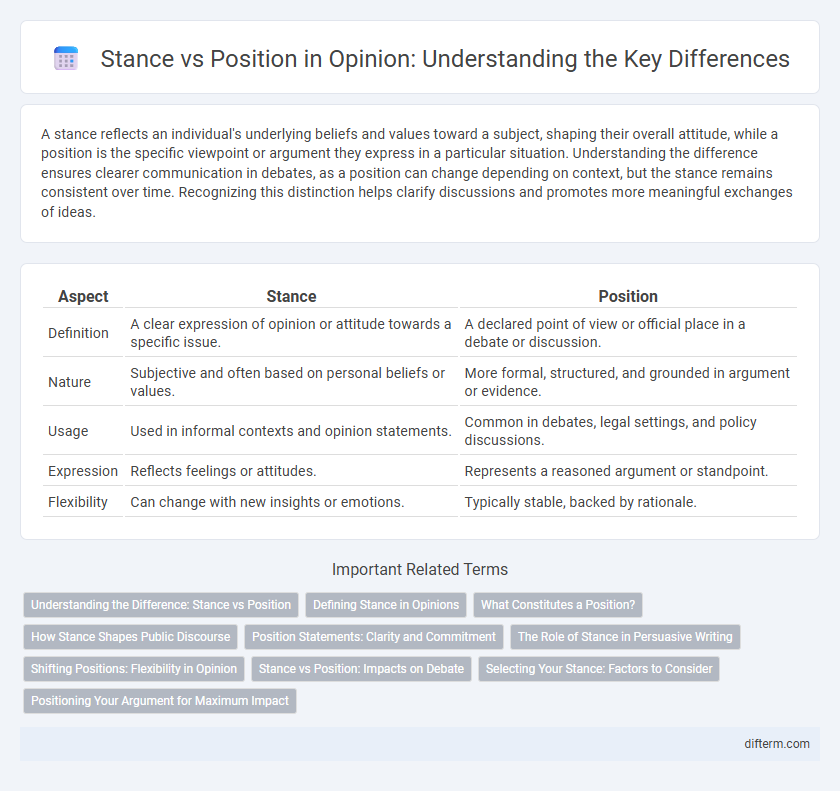A stance reflects an individual's underlying beliefs and values toward a subject, shaping their overall attitude, while a position is the specific viewpoint or argument they express in a particular situation. Understanding the difference ensures clearer communication in debates, as a position can change depending on context, but the stance remains consistent over time. Recognizing this distinction helps clarify discussions and promotes more meaningful exchanges of ideas.
Table of Comparison
| Aspect | Stance | Position |
|---|---|---|
| Definition | A clear expression of opinion or attitude towards a specific issue. | A declared point of view or official place in a debate or discussion. |
| Nature | Subjective and often based on personal beliefs or values. | More formal, structured, and grounded in argument or evidence. |
| Usage | Used in informal contexts and opinion statements. | Common in debates, legal settings, and policy discussions. |
| Expression | Reflects feelings or attitudes. | Represents a reasoned argument or standpoint. |
| Flexibility | Can change with new insights or emotions. | Typically stable, backed by rationale. |
Understanding the Difference: Stance vs Position
Stance refers to a person's underlying attitude or belief about a topic, shaping how they interpret information and respond emotionally. Position denotes the explicit, often public, statement someone takes on an issue, reflecting their chosen side in a debate or argument. Understanding the difference between stance and position clarifies the depth of conviction versus the strategic expression of that conviction in communication.
Defining Stance in Opinions
Stance in opinions refers to the speaker's or writer's expressed attitude or evaluation toward a topic, indicating approval, disapproval, or neutrality. Unlike position, which often denotes a fixed or formal viewpoint, stance captures the nuanced, contextual, and dynamic expression of beliefs or feelings. Defining stance involves analyzing language features such as modality, evaluative adjectives, and hedging to reveal subjective commitment within communication.
What Constitutes a Position?
A position is a clearly defined stance that reflects an individual's or group's specific viewpoint on an issue, supported by reasons and evidence. Unlike a general stance, a position involves a deliberate and articulated judgment intended to persuade or inform. It encompasses not only what is believed but also the rationale and implications tied to that belief.
How Stance Shapes Public Discourse
Stance significantly shapes public discourse by influencing how individuals and groups frame their arguments and interpret information. The expression of stance reveals underlying values and beliefs that guide communication, making it a powerful tool for persuasion and identity construction. Understanding the distinction between stance and position enhances critical analysis of debates and media narratives.
Position Statements: Clarity and Commitment
Position statements provide clarity by explicitly defining an organization's or individual's firm stance on specific issues, eliminating ambiguity and enhancing communication effectiveness. Clear and concise wording in position statements fosters trust and accountability, signaling a committed viewpoint that guides decision-making and stakeholder expectations. Commitment in these statements reinforces credibility, ensuring that the declared position is perceived as reliable and enduring.
The Role of Stance in Persuasive Writing
Stance plays a crucial role in persuasive writing by clearly conveying the writer's attitude and commitment toward the topic, shaping how arguments are framed and received by the audience. Unlike a mere position, stance reflects underlying values and emotions, enhancing credibility and engagement through nuanced language and rhetorical strategies. This dynamic engagement fosters a deeper connection with readers, increasing the effectiveness of persuasion in essays, speeches, and debates.
Shifting Positions: Flexibility in Opinion
Shifting positions demonstrates intellectual flexibility and openness to new information, reflecting a dynamic approach to forming opinions. Maintaining a stance too rigidly can limit understanding and hinder constructive dialogue, while adapting positions promotes growth and deeper insight. Embracing change in perspective allows individuals to refine beliefs in response to evolving evidence and reasoning.
Stance vs Position: Impacts on Debate
Stance and position significantly influence the dynamics of a debate by shaping argument strength and clarity. A stance reflects an individual's overall attitude or belief on an issue, while a position represents a specific viewpoint or course of action within that stance. Differentiating between these concepts enhances persuasive communication and fosters more structured, effective debates.
Selecting Your Stance: Factors to Consider
Selecting your stance requires evaluating the clarity of your message, the audience's values, and the relevance of supporting evidence. A well-defined stance aligns closely with your core beliefs and is adaptable to contextual nuances while maintaining consistency. Prioritizing these factors enhances persuasive communication and strengthens the overall impact of your argument.
Positioning Your Argument for Maximum Impact
Positioning your argument effectively involves clearly defining your stance and framing it to resonate with your audience's values and beliefs. Emphasizing strong evidence and logical reasoning enhances the credibility of your position, making it more persuasive. Strategic positioning aligns your argument with relevant cultural or social contexts, increasing its impact and acceptance.
stance vs position Infographic

 difterm.com
difterm.com